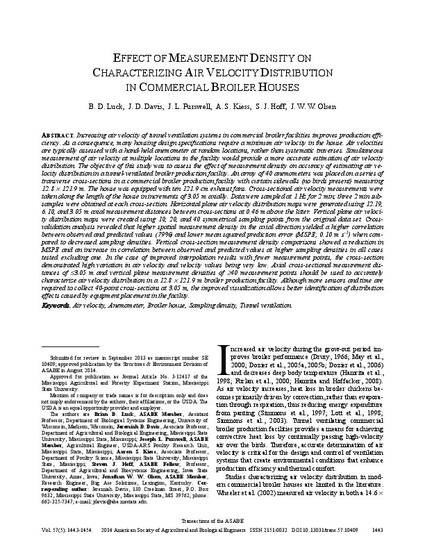
Increasing air velocity of tunnel ventilation systems in commercial broiler facilities improves production efficiency. As a consequence, many housing design specifications require a minimum air velocity in the house. Air velocities are typically assessed with a hand-held anemometer at random locations, rather than systematic traverses. Simultaneous measurement of air velocity at multiple locations in the facility would provide a more accurate estimation of air velocity distribution. The objective of this study was to assess the effect of measurement density on accuracy of estimating air velocity distribution in a tunnel-ventilated broiler production facility. An array of 40 anemometers was placed on a series of transverse cross-sections in a commercial broiler production facility with curtain sidewalls (no birds present) measuring 12.8 × 121.9 m. The house was equipped with ten 121.9 cm exhaust fans. Cross-sectional air velocity measurements were taken along the length of the house in increments of 3.05 m axially. Data were sampled at 1 Hz for 2 min; three 2 min subsamples were obtained at each cross-section. Horizontal plane air velocity distribution maps were generated using 12.19, 6.10, and 3.05 m axial measurement distances between cross-sections at 0.46 m above the litter. Vertical plane air velocity distribution maps were created using 10, 20, and 40 symmetrical sampling points from the original data set. Cross-validation analysis revealed that higher spatial measurement density in the axial direction yielded a higher correlation between observed and predicted values (79%) and lower mean squared prediction error (MSPE; 0.10 m s-1) when compared to decreased sampling densities. Vertical cross-section measurement density comparisons showed a reduction in MSPE and an increase in correlation between observed and predicted values at higher sampling densities in all cases tested excluding one. In the case of improved interpolation results with fewer measurement points, the cross-section demonstrated high variation in air velocity and velocity values being very low. Axial cross-sectional measurement distances of =3.05 m and vertical plane measurement densities of =40 measurement points should be used to accurately characterize air velocity distribution in a 12.8 × 121.9 m broiler production facility. Although more sensors and time are required to collect 40-point cross-sections at 3.05 m, the improved visualization allows better identification of distribution effects caused by equipment placement in the facility.
Available at: http://works.bepress.com/steven_hoff/134/

This article is from Transactions of the ASABE 57 (2014): 1443–1454, doi:10.13031/trans.57.10409. Posted with permission.